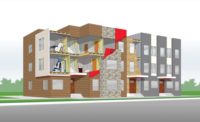Specialized Performance Gypsum Panels for Single-family Homes

There’s value in using specialized gypsum panels for a home. But the benefits don’t stop there.
With housing starts remaining strong during the first quarter of 2018, and residential remodeling experiencing a sustained uptick, it is a good time to reflect on how specialized performance gypsum panels can offer value to those seeking a new home or remodeling an older home.
Unfortunately, many builders of single-family housing, and consumers of remodeling services are unware of products such as exterior gypsum sheathing, mold and moisture resistant gypsum panels and abuse and impact resistant gypsum panels. Often, homeowners are not even aware of the existence of type X wallboard—a staple of enhanced performance interior construction.
Certainly, I wish I had known more about the array of gypsum panel product offerings years ago when my husband and I purchased an old house. A number of crumbling plaster walls needed replacement as did walls with wood paneling installed to hide, what else, crumbling plaster. We were not afraid; both of us had old house renovations under our belts. Still, this old-house preference may have had negative ramifications for the children. On visiting our future home for the first time, my youngest daughter plaintively asked, “For once, could we buy a house that’s already fixed up?”
The New Product on the Block
Built in 1873, the “new” house would be the oldest we had lived in, but its condition was better that than that of the 1930s starter home my husband bought in the mid-1990s. He recalls his father’s reaction to the state of that property: “Should I go for the gasoline and matches now, or later?” As for me, I had spent enough hours widening plaster cracks, filling with setting-type joint compound, sanding, priming, and painting in my own 1930s bungalow that the prospect of new gypsum board was positively exciting.
In retrospect, however, I would have gone the extra mile and used type X gypsum board because of its additional fire resistance and extra mass and density. What we have is code compliant, but why not go above code? Frankly, if our combined family had skewed younger, I would have considered abuse- or impact-resistant panels for the central hallway both upstairs and down. As it is, when we host the neighborhood New Year’s Eve party, I hold my breath when the tweens inevitably start tearing up and down the stairs. Sorry to say, it’s not the children I’m worried about. Fortunately, gypsum board is readily repairable. Yet, I dread the prospect of listening to my husband sighs—when and if—he is forced to make repairs to those walls.
There are signs of growing awareness and use of these special performance boards in single family homes and builders and contractors should take note. A local developer who built six new single family homes in our historic neighborhood uses type X exclusively. In fact, his overall emphasis on building materials upgrades has turned me into a supporter of his proposal for a larger development on a long abandoned 6-acre site right down the street from my home. My thinking: Infill development is inevitable in our close-in suburb, so let it be high quality housing stock. I’d like the new houses to last as long as the historic homes.
On the annual preservation association house tour, I was pleased to learn that one neighbor not only used type X throughout his old house during renovation but also specified mold and moisture resistant panels for the bathrooms. Unfortunately, the drywall hanger didn’t pay attention to that detail, and the homeowner was disappointed when he returned to find type X installed in the bathrooms. So far, things are holding up well. If bit of mold eventually appears, I suspect there will be some second thoughts about letting that oversight go unaddressed.
Certainly, I’m looking forward to incorporating mold/moisture resistant board in our inevitable bathroom remodel. Mysteriously, we when purchased our home the only updated room was the bathroom, which features a contemporary claw foot tub. While I’m still spry enough to enter and exit said tub, today, I’m not sure I’ll feel that confident in 10 years or so, despite the handles my husband has installed. A shower stall would be more convenient and present less of a challenge to an older adult. While we are at it, we may turn the first floor half-bath into a full bathroom in anticipation of single floor living. You can be sure that bathroom also will feature the latest in mold and moisture resistance panels.
If we want to keep open the option of downsizing, however, there is one project that that should come sooner, rather than later. Our aged basement, which also serves as laundry room, pantry, and occasional wood shop, becomes damp when it rains. Like another old house I renovated, this basement does not run the full length and width of the house. Instead, it sits under just half of the house. My husband sees remediation as an opportunity to shore up the foundation while we take the necessary measures to redirect the water and create a dry basement. At the same time, we can expand.
Multi-performance Gypsum Panels
Creating living or sleeping space would be a possibility for the new part of the basement. I doubt it is one I would seriously consider, given the fact that we will soon be empty-nesters. However, the wood shop could move entirely into this new space, containing the saw dust that lands on the lids of my canned goods and gives me pause when I hang wash to dry in the basement. Our humid environment will never change, and I would spec a multi-attribute gypsum panel that combines a type X core, mold and moisture resistance, and abuse or impact resistance. If we engage in this major project, given the heavy use the room would receive as a shop, impact or abuse resistant panels on the walls would minimize wear and tear.
My goal is two-fold: create a space that we can take advantage of while we own the house and an asset that make our property more attractive if we decide to sell. Future owners of the house may wish to put the room to a different use. Plus, scary basement syndrome is real; there is nothing as off-putting to potential buyers as a murky basement.
Obviously, it doesn’t bother my family as much as many others but then we are used to living in old houses. In fact, the same daughter who complained about moving into yet another old house, recently pointed to a ramshackle, boarded up row house in Pittsburgh and said, “If I stay in this city, I could buy one of those houses and renovate—that’s my favorite one.” I guess the old saying is true, the apple doesn’t fall far from the tree.
Ironically, it is living in an old house that makes these very up-to-date specialized performance boards so appealing. There is already enough maintenance to qualify old-house ownership as a kind of hobby, especially if you or your partner has the knowledge, skills, and ability to tackle many jobs. When the basement work goes forward, I assume my husband’s role will be limited to construction observation, at least initially. That may mean time and attention can be given to a “little project” that remains undone despite all the years since our renovation and move in.
You see, there is another old saw our family has adapted to reflect our particular circumstances: “The carpenter’s children have no shoe molding.”
Intrigued by the possibilities specialized performance gypsum panels represent? The Gypsum Association website features a quick reference guide to ideas and information for better construction results with gypsum panel products for several building types, including single-family homes. Visit www.gypsum.org/single-family.
Looking for a reprint of this article?
From high-res PDFs to custom plaques, order your copy today!









